
–1
–2
(1) (2)
周辺光量について
•
レンズは原理的に画面周辺部の光量が中心部に比べ低下
します。周辺光量の低下が気になる場合は、開放絞りか
ら1〜
2
段絞り込んでご使用ください。
各部のなまえ
1
レンズフード指標
2
フォーカスリング
3
距離目盛/倍率目盛
4
距離指標
5
レンズ信号接点
*
6
フォーカスホールドボタン
7
フォーカスレンジ切り替えスイッチ
8
手ブレ補正スイッチ
9
マウント標点
*
直接手で触れないでください。
レンズの取り付けかた/取りは
ずしかた
取り付けかた(イラスト
–
参照)
1
前後のレンズキャップとカメラのボディ
キャップをはずす。
•
レンズフロントキャップは図の(
1
)、(
2
)の
2
通りの方
法で取り付け/取りはずしができます。(
2
)は、レン
ズフードを付けた状態でのレンズキャップの取り付
け/取りはずしに便利です。
2
レンズとカメラの白の点(マウント標点)を合
わせてはめ込み、レンズを軽くカメラに押し
当てながら、時
計方向に「カチッ」とロックが
かかるまでゆっくり回す。
•
レンズを取り付けるときは、カメラのレンズ取りは
ずしボタンを押さないでください。
•
レンズを斜めに差し込まないでください。
取りはずしかた(イラスト
–
参照)
カメラのレンズ取りはずしボタンを押したま
ま、レンズを反時計方向に回してはずす。
レンズフードを取り付ける
画面外にある光が描写に影響するのを防ぐために、レンズ
フードの使用をおすすめします。
レンズフードの赤線をレンズの赤線(レンズ
フード指標)に合わせてはめ込み、レンズフード
の赤点とレンズの赤線が合って「カチッ」という
まで時計方向に回す。
•
外付けフラッシュ(別売)を使って撮影するときは、フ
ラッシュ光が遮られることがありますので、レンズフー
ドをはずしてください。
•
撮影後レンズフードを収納するときは、逆向きにレンズ
に取り付けてください。
ピントを合わせる
ピント合わせは、以下
3
つの設定方法があります。
•
オートフォーカス
ピント合わせを自動で行う。
•
DMF
(ダイレクトマニュアルフォーカス)
オートフォーカスでピントを合わせた後に、マニュアルで
ピントを微調整する。
•
マニュアルフォーカス
ピント合わせを手動で行う。
•
本製品のフォーカスモード切り替えは、一部のカメラ本
体においてお使いになれません。
カメラ本体との互換情報については専用サポートサイト
でご確認ください。
AF
(オートフォーカス)/
MF
(マニュアル
フォーカス)の切り替え
AF
(オートフォーカス
:
自動ピント合わせ)/
MF
(マニュ
アルフォーカス
:
手動によるピント合わせ)の設定を、レン
ズ側で切り替えることができます。
AF
で撮影する場合は、カメラ側とレンズ側両方の設定を
AF
にします。カメラ側あるいはレンズ側のいずれか一方、
または両方の設定が
MF
の場合、
MF
になります。
レンズ側の設定(
1
)
AF
:フォーカスリングをの位置にセットする。
MF
:フォーカスリングをの位置にセットする。
•
カメラのフォーカスモードの設定方法については、カメ
ラの取扱説明書をご覧ください。
•
MF
ではファインダー等を見ながらフォーカスリングを
回して、ピントを合わせます(
2
)。距離目盛は目安です。
•
フォーカスリングを
AF
モード位置から
MF
モード位置
に動かすと、そのときの距離目盛の撮影距離にピント
が調整されます。
AF/MF
コントロールボタンを装備したカメラをお
使いの場合
•
AF
時に
MF
に切り替えるには、カメラとレンズ両方の設
定が
AF
のときに、
AF/MF
コントロールボタンを押しま
す。
•
MF
時に
AF
に切り替えるには、カメラの設定が
MF
、レン
ズの設定が
AF
のときに、
AF/MF
コントロールボタンを
押します。
手ブレ補正を使用する
手ブレ補正スイッチ
•
ON
:
手ブレを補正します。
•
OFF
:
手ブレを補正しません。三脚をお使いになる場合
は、手ブレ補正を
OFF
にすることをおすすめしま
す。
フォーカスホールドボタンを使
用する
•
本製品のフォーカスホールドボタンは、一部のカメラ本
体においてお使いになれません。
カメラ本体との互換情報については専用サポートサイト
でご確認ください。
AF
中にフォーカスホールドボタンを押すと、
AF
の駆動を
止めることができます。ピントが固定され、そのままのピ
ントでシャッターを切れます。シャッターボタンを半押
しした状態で、フォーカスホールドボタンを離すと、
AF
が
再開します。
(1) (2)
フォーカスレンジ(
AF
駆動範囲)
を切り替える
AF
の駆動範囲を切り替えて、ピント合わせの時間を短縮で
きます。撮影距離が一定の範囲内に限られている場合に
便利です。
フォーカスレンジ切り替えスイッチで、撮影距
離範囲を選択する。
•
FULL
:
距離制限はありません。全域で
AF
が駆
動します。
•
∞
-0.5m
:
無限遠から
0.5m
まで
AF
が駆動します。
•
0.5m-0.28m: 0.5m
から最短撮影距離まで
AF
が駆動し
ます。
*
*
一部のカメラ本体においては
FULL
と同じ撮影距離範囲
となります。カメラ本体と互換情報については専用サ
ポートサイトでご確認ください。
マクロ撮影について
撮影倍率
倍率目盛が距離目盛に比率で表示されています。
•
撮影倍率が高くなるとカメラぶれが目立ちやすくなりま
すので、撮影時は三脚等でカメラをしっかり固定してく
ださい。
市販の露出計、マニュアルフラッシュ撮影のご注意
近距離撮影でレンズの明るさが暗くなります。
カメラの
AUTO
モードなどの自動露出撮影やメータードマ
ニュアル撮影の場合は露出が自動補正されますので、その
まま撮影できます。
市販の露出計を使用する場合や、一部のフラッシュに搭載
されているマニュアルフラッシュ撮影機能を使って撮影
する場合は、指示値に対して露出を増やしてください。(補
正量については、露出補正量表をご覧ください。)
露出補正量表について
a
露出補正段数
b
撮影倍率
c
撮影距離
•
撮影倍率と撮影距離の関係は目安です。
主な仕様
商品名(型名)
FE 90mm F2.8 Macro
G OSS
(SEL90M28G)
焦点距離(
mm
)
90
焦点距離イメージ
*
1
(
mm
)
135
レンズ群一枚
11-15
画角
1*
2
27
°
画角
2*
2
17
°
最短撮影距離
*
3
(
m
)
0.28
最大撮影倍率(倍)
1.0
最小絞り
F22
フィルター径(
mm
)
62
外形寸法(最大径×長さ)
(約:
mm
)
79
×
130.5
質量(約:
g
)
602
手ブレ補正機能 あり
*
1
撮像素子が
APS-C
サイズ相当のレンズ交換式デジタル
カメラ装着時の
35mm
判換算値を表します。
*
2
画角
1
は
35mm
判カメラ、画角
2
は
APS-C
サイズ相当の撮
像素子を搭載したレンズ交換式デジタルカメラでの値
を表します。
*
3
最短撮影距離とは、撮像素子面から被写体までの距離を
表します。
•
レンズの機構によっては、撮影距離の変化に伴って焦点
距離が変化する場合があります。記載の焦点距離は撮影
距離が無限遠での定義です。
同梱物:レンズ(
1
)、レンズフロントキャップ(
1
)、レンズリ
ヤキャップ(
1
)、レンズフード(
1
)、レンズケース(
1
)、印刷物
一式
仕様および外観は、改良のため予告なく変更することがあ
りますが、ご了承ください。
および はソニー株式会社の商標です。
This instruction manual explains how to use
lenses. Notes on use are found in the separate
“Precautions before using”. Be sure to read both
documents before using your lens.
This lens is designed for Sony α camera system
E-mount cameras. You cannot use it on A-mount
cameras.
The FE 90mm F2.8 Macro G OSS is compatible with
the range of a 35mm format image sensor.
A camera equipped with a 35mm format image
sensor can be set to shoot at APS-C size.
For details on how to set your camera, refer to its
instruction manual.
For further information on compatibility, visit the web
site of Sony in your area, or consult your dealer of
Sony or local authorized service facility of Sony.
Notes on use
ˎ When carrying a camera with the lens attached,
always firmly hold both the camera and the lens.
ˎ This lens is not water-proof, although designed with
dust-proofness and splash-proofness in mind. If
using in the rain etc., keep water drops away from
the lens.
Precautions on using a flash
ˎ You cannot use a built-in camera flash with this
lens. Use an external flash (sold separately).
When shooting close to a subject, use an external
macro flash (sold separately).
Vignetting
ˎ When using the lens, the corners of the screen
become darker than the center. To reduce this
phenomena (called vignetting), close the aperture
by 1 to 2 stops.
Switching focus range (AF range)
The focus-range limiter enables you to reduce the
auto focusing time. This is useful when the subject
distance is definite.
Slide the focus-range limiter to select the focus
range.
ˎ FULL: AF is set to the minimum focusing
distance to infinity.
ˎ ∞ - 0.5m: AF is set to 0.5 m (1.64 feet) to infinity.
ˎ 0.5m-0.28m: AF changes from 0.5 m (1.64 feet) to
the minimum focus length.*
* Depending on the camera model, AF may be set to
the same focus range as when setting the focus-
range limiter to FULL. For further information on
compatibility, visit the web site of Sony in your area,
or consult your dealer of Sony or local authorized
service facility of Sony.
Macro photography
Magnification ratios
The magnification scale is located on the distance
scale.
ˎ As the magnification increases, the camera is more
vulnerable to shaking. Use a tripod to steady the
camera when shooting.
Precautions on using a commercially
available exposure meter or manual
flash shooting function
When shooting close to a subject, the brightness of
the lens is reduced.
When shooting in automatic exposure mode or
metered manual mode (for example, the camera’s
AUTO mode), the exposure is adjusted automatically.
When using a commercially available exposure meter
or shooting with the manual flash function available
on some external flash units, set the exposure
higher than the indicated value. (For information on
the exposure compensation, refer to the exposure
compensation table .)
Exposure compensation table
a Exposure correction
b Magnification ratios
c Distance
ˎ The relationship between magnification and
distance shown in the table is a rough guide.
Specifications
Name (Model name)
FE 90mm F2.8 Macro
G OSS
(SEL90M28G)
Focal length (mm) 90
35mm equivalent
focal length*
1
(mm)
135
Lens groups-elements 11-15
Angle of view 1*
2
27°
Angle of view 2*
2
17°
Minimum focus*
3
(m (feet)) 0.28 (0.92)
Maximum magnification (×) 1.0
Minimum aperture f/22
Filter diameter (mm) 62
Dimensions
(maximum diameter × height)
(approx., mm (in.))
79 × 130.5
(3 1/8 × 5 1/4)
Mass (approx., g (oz.)) 602 (21.3)
Shake compensation function Yes
*
1
This is the equivalent focal length in 35mm format
when mounted on an Interchangeable Lens Digital
Camera equipped with an APS-C sized image sensor.
*
2
Angle of view 1 is the value for 35mm cameras, and
angle of view 2 is the value for Interchangeable Lens
Digital Cameras equipped with an APS-C sized image
sensor.
*
3
Minimum focus is the distance from the image sensor
to the subject.
ˎ Depending on the lens mechanism, the focal length
may change with any change in shooting distance.
The focal lengths given above assume the lens is
focused at infinity.
Included items: Lens (1), Front lens cap (1), Rear lens
cap (1), Lens hood (1), Lens case (1), Set of printed
documentation
Designs and specifications are subject to change
without notice.
and is a trademark of Sony Corporation.
Ce mode d’emploi explique comment se
servir des objectifs. Les remarques concernant
l’emploi se trouvent dans le document distinct
«Précautions avant toute utilisation ». Veuillez lire
les deux documents avant d’utiliser votre objectif.
Cet objectif est conçu pour les appareils photo
pourvus d’une monture E de type Sony α. Il ne peut
pas être utilisé sur les appareils photo pourvus d’une
monture A.
L’objectif FE 90mm F2.8 Macro G OSS est compatible
avec la plage d’un capteur d’image de format 35 mm.
Un appareil photo équipé d’un capteur d’image de
format 35 mm peut être réglé pour la prise de vue en
APS-C.
Pour les détails sur la manière de régler l’appareil
photo, reportez-vous à son mode d’emploi.
Pour plus d’informations sur la compatibilité,
consultez le site de Sony de votre pays, ou adressez-
vous à un revendeur Sony ou à un service après-
vente agréé Sony.
Remarques sur l’emploi
ˎ Lorsque vous portez un appareil photo avec
l’objectif dessus, tenez toujours fermement
l’appareil photo et l’objectif.
Identifying the parts
1 Lens hood index
2 Focusing ring
3 Distance scale / Magnification scale
4 Distance index
5 Lens contacts*
6 Focus-hold button
7 Focus-range limiter
8 Shake compensation switch
9 Mounting index
* Do not touch the lens contacts.
Attaching/detaching the lens
To attach the lens
(See illustration –.)
1
Remove the rear and front lens caps
and the camera body cap.
ˎ You can attach/detach the front lens cap in
two ways, (1) and (2). When you attach/detach
the lens cap with the lens hood attached, use
method (2).
2
Align the white dot on the lens barrel
with the white dot on the camera
(mounting index), then insert the lens
into the camera mount and rotate it
clockwise until it locks.
ˎ Do not press the lens release button on the
camera when mounting the lens.
ˎ Do not mount the lens at an angle.
To remove the lens
(See illustration –.)
While holding down the lens release button on
the camera, rotate the lens counterclockwise
until it stops, then detach the lens.
Attaching the lens hood
It is recommended that you use a lens hood to
reduce flare and ensure maximum image quality.
Align the red line on the lens hood with the red
line on the lens (lens hood index), then insert
the lens hood into the lens mount and rotate it
clockwise until it clicks into place and the red
dot on the lens hood is aligned with the red
line on the lens (lens hood index).
ˎ When using an external flash (sold separately),
remove the lens hood to avoid blocking the flash
light.
ˎ When storing, fit the lens hood onto the lens
backwards.
Focusing
There are three ways to focus.
ˎ Auto focus
The camera focuses automatically.
ˎ DMF (Direct manual focus)
After the camera focuses in auto focus, you can make
a fine adjustment manually.
ˎ Manual focus
You focus manually.
ˎ The focus mode of this lens cannot be switched
with some camera models.
For further information on compatibility, visit the
web site of Sony in your area, or consult your dealer
of Sony or local authorized service facility of Sony.
To switch AF (auto focus)/MF (manual
focus)
The focus mode can be switched between AF and MF
on the lens.
For AF photography, both the camera and lens should
be set to AF. For MF photography, either or both the
camera or lens should be set to MF.
To set the focus mode on the lens (1)
AF: Set the focus ring to the position.
MF: Set the focus ring to the position.
ˎ Refer to the camera manuals to set the focus mode
of the camera.
ˎ In MF, turn the focusing ring to adjust the focus
(2) while looking through the viewfinder, etc. The
distance scale is only a rough guide.
ˎ When you move the focus ring from AF mode
to MF mode , focus is adjusted to the distance
indicated on the distance scale.
To use a camera equipped with an AF/MF
control button
ˎ Press the AF/MF control button to switch AF to MF
when both the camera and lens are set to AF.
ˎ Press the AF/MF control button to switch MF to AF
when the camera is set to MF and the lens is set to
AF.
Using the shake compensation
function
Shake compensation switch
ˎ ON: Compensate for camera shake.
ˎ OFF: Does not compensate for camera shake. We
recommend setting the shake compensation
switch to OFF when shooting with a tripod.
Using focus-hold buttons
ˎ The focus-hold button of this lens does not function
with some camera models.
For further information on compatibility, visit the
web site of Sony in your area, or consult your dealer
of Sony or local authorized service facility of Sony.
Press the focus-hold button in AF to cancel AF. The
focus is fixed and you can release the shutter on
the fixed focus. Release the focus-hold button while
pressing the shutter button halfway to start AF again.
ˎ Cet objectif n’est pas étanche bien qu’il soit conçu
pour résister à la poussière et aux éclaboussures. Si
vous l’utilisez sous la pluie, etc., veillez à ce que de
l’eau ne tombe pas dessus.
Précautions concernant l’emploi d’un flash
ˎ Vous ne pouvez pas utiliser le flash de votre
appareil photo avec cet objectif. Utilisez un flash
externe (vendu séparément).
Lors de la prise de vue rapprochée d’un sujet,
utilisez un flash macro externe (vendu séparément).
Vignetage
ˎ Lorsque l’objectif est utilisé, les coins de l’écran
deviennent plus sombres que le centre. Pour
réduire ce phénomène (appelé vignetage), fermez
l’ouverture d’un ou de deux crans.
Identification des éléments
1 Repère de parasoleil
2 Bague de mise au point
3 Échelle des distances / grossissement
4 Indice de distance
5 Contacts d’objectif*
6 Bouton de maintien de la mise au point
7 Limiteur d’amplitude focale
8 Commutateur antibougé
9 Repère de montage
* Ne touchez pas les contacts d’objectif.
Pose et dépose de l’objectif
Pour poser l’objectif
(Voir l’illustration –.)
1
Déposez les capuchons d’objectif
arrière et avant et le capuchon de
l’appareil photo.
ˎ Vous pouvez poser et déposer le capuchon
d’objectif avant de deux façons, (1) et (2). Si vous
posez ou déposez le capuchon d’objectif avec le
parasoleil, utilisez la méthode (2).
2
Alignez le repère blanc du barillet
d’objectif sur le repère blanc de
l’appareil photo (repère de montage),
puis posez l’objectif sur la monture de
l’appareil photo et tournez-le dans le
sens des aiguilles d’une montre jusqu’à
ce que vous entendiez un déclic.
ˎ N’appuyez pas sur le bouton de libération de
l’objectif de l’appareil photo lorsque vous posez
l’objectif.
ˎ Ne posez pas l’objectif de biais.
Pour déposer l’objectif
(Voir l’illustration –.)
Tout en appuyant sur le bouton de libération
de l’objectif sur l’appareil photo, tournez
l’objectif dans le sens contraire des aiguilles
d’une montre jusqu’à l’arrêt, puis déposez
l’objectif.
Fixation du parasoleil
Il est conseillé d’utiliser un parasoleil pour réduire
la lumière parasite et obtenir la meilleure image
possible.
Alignez la ligne rouge du parasoleil sur la ligne
rouge de l’objectif (repère de parasoleil), puis
insérez le parasoleil sur la monture d’objectif
et tournez-le dans le sens des aiguilles d’une
montre jusqu’à ce qu’il s’encliquette et le point
rouge du parasoleil s’aligne sur la ligne rouge
de l’objectif (repère de parasoleil).
ˎ Si vous utilisez un flash externe (vendu
séparément), retirez le parasoleil pour éviter de
bloquer la lumière du flash.
ˎ Pour ranger le parasoleil, insérez-le à l’arrière de
l’objectif.
Mise au point
La mise au point peut être réalisée de trois façons.
ˎ Mise au point automatique
L’appareil photo fait automatiquement la mise au
point.
ˎ DMF (Mise au point manuelle directe)
Après la mise au point en autofocus, vous pouvez
effectuer un réglage plus fin manuellement.
ˎ Mise au point manuelle
Vous faites vous-même la mise au point.
ˎ Le mode de mise au point de cet objectif ne peut
pas être changé sur certains modèles d'appareils
photo.
Pour plus d’informations sur la compatibilité,
consultez le site de Sony de votre pays, ou
adressez-vous à un revendeur Sony ou à un service
après-vente agréé Sony.
Pour commuter entre AF (mise au
point automatique) et MF (mise au
point manuelle)
Il est possible de régler le mode de mise au point sur
AF ou MF sur l’objectif.
Pour la photographie en mode AF, l’appareil photo et
l’objectif doivent être tous les deux réglés sur AF. Pour
la photographie en mode MF, l’appareil photo ou
l’objectif, ou bien les deux, doivent être réglés sur MF.
Pour régler le mode de mise au point sur
l’objectif (1)
AF : positionnez la bague de mise au point sur
.
MF : positionnez la bague de mise au point sur
.
(Suite à la page arrière)
4-563-614-01(1)
©2015 Sony Corporation
SEL90M28G
交換レンズ
Interchangeable Lens
Objectif interchangeable
取扱説明書
Operating Instructions
Mode d’emploi
Manual de
instrucciones
E-mount
Printed in Thailand
FE 90mm F2.8 Macro G OSS
a
b
1.00X
(1:1)
0.88X
(1:1.13)
0.73X
(1:1.37)
0.54X
(1:1.84)
0.37X
(1:2.67)
0.22X
(1:4.4)
0.09X
(1:11)
+2 0
0.28 0.29 0.30 0.33 0.40 0.56 1.19 ∞m
c
+1
2
3
+1
1
3
+1 +
1
3
+
2
3
1 5
3 4
6 7
2
8 9
電気製品は、安全のための注意事項を守
らないと、人身への危害や火災などの財
産への損害を与えることがあります。
この取扱説明書には、事故を防ぐための重要な注意事項と
製品の取り扱いかたを示しています。この取扱説明書を
よくお読みの上、製品を安全にお使いください。お読みに
なったあとは、いつでも見られる所に必ず保管してくださ
い。
この「取扱説明書」ではレンズの使いかたを説明してい
ます。使用上のご注意などは別冊の「使用前のご注意」
でご覧頂けます。
必ずご使用の前に、本書と合わせてよくお読みのうえ
でご使用ください。
本機はソニー製αカメラシステム
E
マウントカメラ専用の
レンズです。
A
マウントカメラにはお使いになれません。
また、
35mm
判相当の撮像素子に対応しています。
35mm
判相当の撮像素子搭載機種ではカメラ設定によっ
て
APS-C
サイズの撮影が可能です。
カメラの設定方法については、カメラの取扱説明書をご覧
ください。
(カメラ本体との互換情報については)専用サポートサイ
トでご確認ください。
http://www.sony.co.jp/DSLR/support/
使用上のご注意
•
レンズを取り付けてカメラを持ち運ぶときは、カメラと
レンズの両方をしっかり持ってください。
•
本機は防じん、防滴性に配慮して設計されていますが、防
水性能は備えていません。雨中使用時などは、水滴がか
からないようにしてください。
フラッシュ使用時のご注意
•
カメラ内蔵フラッシュはお使いになれません。外付けフ
ラッシュ(別売)をご使用ください。
また、近接撮影時には、外付けマクロフラッシュ(別売)を
ご使用ください。

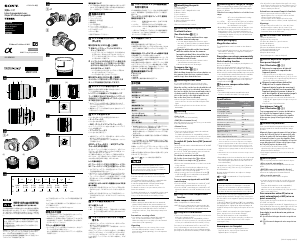


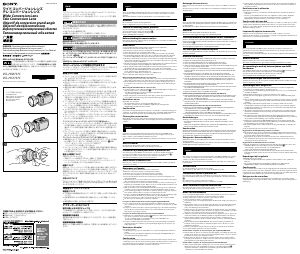
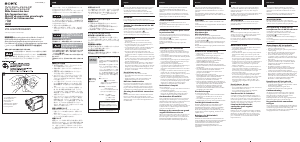

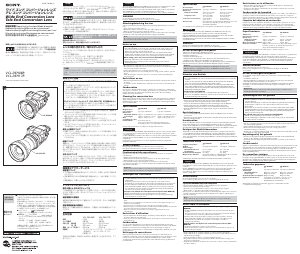
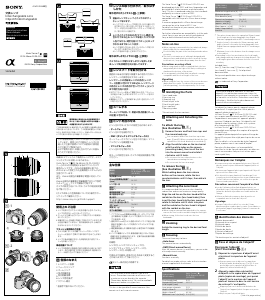
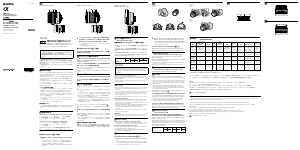
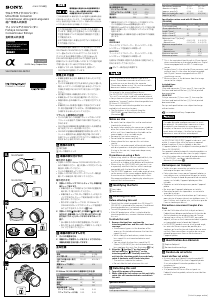
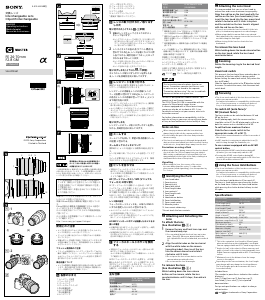
この商品に関する会話に参加する
ここでは、ソニー SEL90M28G カメラレンズ についての意見を共有できます。 疑問がある場合は、まず説明書をよく読んでください。 マニュアルのご請求は、お問い合わせフォームより承ります。